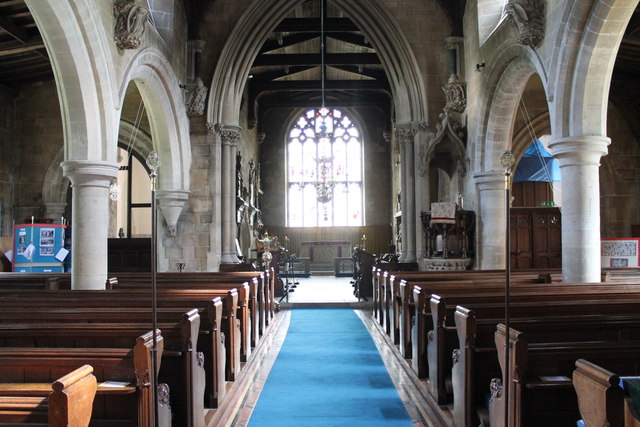Uses for an altar table
Updated
The role (and other aspects) of the altar or holy table will be considered in some detail in a future post. But this story in today’s press is of some interest.
The Daily Telegraph reports that Lincoln diocese has banned [a church] from using altar to serve cups of tea.
According to the report
Worshippers at the St Michael and All Angels Church in Uffington, Lincolnshire, wanted their oak altar to double up as a place to “serve refreshments”.
Update: Law and Religion UK provides some more details. Perhaps most significant is that the altar is one in a chapel, not the church’s main altar, pictured above and in the Telegraph report. The petition was to place a table in the chapel which could be used to serve refreshments, and which would be used occasionally as an altar.
But the Chancellor of the diocese, Mark Bishop,
23 Commentsdecided the altar could only be used for worship, not to serve snacks.
Ruling that “an interchangeable use for the altar” was certainly not acceptable, he said a “decent table of wood, stone or other suitable material” should be provided in every church or chapel for celebration of Holy Communion.
He added: “The table, as becomes the table of Lord, shall be kept in a sufficient and seemly manner, and from time to time repaired, and shall be covered in the time of Divine Service with a covering of silk or other decent stuff, and with a fair white linen cloth at the time of the celebration of the Holy Communion.
“It would be completely inappropriate for an altar to be used occasionally for the celebration of Holy Communion, but more frequently ‘for the service of refreshments’.
“The obligation of the Churchwardens is to ensure that the Lord’s Table is kept in a ‘sufficient and seemly manner’ and I am quite satisfied that what is proposed does not amount to that.”
Liturgy for the reburial of a long-dead king and a liturgical re-ordering project
There probably aren’t many examples to hand for the authorities at Leicester Cathedral, who will be compiling the service for the re-burial of Richard III, scheduled for Thursday 26 March 2015.
In a press release last week the Cathedral authorities say that
- On Sunday 22 March the University of Leicester will transfer the mortal remains into a lead-lined coffin and they will travel from Leicester to Bosworth
- In the evening, the remains of Richard III will be received into the care of the Cathedral
- They will lie in repose for 3 days
- They will be reburied on the morning of Thursday 26 March
- The next days, Friday 27 March and Saturday 28 March, the tomb stone itself will be put in place and revealed and there will be a service to mark the completion of the reinterment.
The reburial service will be broadcast live on Channel 4, with highlights being shown in the evening.
Further details can be read on the Cathedral’s Richard III site.
We hope that liturgical material associated with these events will be available to link to nearer the time. Here is what the Cathedral is saying right now:
[T]his raises interesting questions about language. Vespers of the Dead is not familiar today and services were in Latin. Praying for the dead can be a controversial issue, but, despite the condemnation in the Articles of Faith, is part of Anglican practice, although not for all. And in law the Church of England is a continuous body since Saxon times, therefore we are the successor of the Church to which Richard belonged, so an Anglican funeral is entirely right, however we choose to diversify within that. … So what we shall do with Richard, is sculpt something which both recognises tradition and Richard’s faith, but speaks also to the modern world.
Meanwhile the Cathedral is appealing for £2.5 millions for the re-ordering project which will include a fitting setting for the King’s remains. Some details of the reordering can be found at the Leicester diocesan website and at the BBC. Although full drawings and images of the current plans do not seem to be generally available, information of the 2013 plans submitted to the Cathedrals Fabric Commission can be found in some detail here. My understanding is that the only substantial change from the earlier plans is in the plinth on which the tomb slab will be placed.
2 CommentsMarking the centenary of the start of the First World War
The Church of England has produced a set of Liturgical Resources for use at services commemorating the anniversary of World War One. They are available here as part of a section of the website dedicated to the commemoration.
A candle-lit vigil of prayer and an act of solemn reflection to mark the centenary of the start of the First World War will be held in Westminster Abbey on 4 August 2014. The service is one of a number of events being announced by the Government to mark the centenary of the Great War. Drawing upon Sir Edward Grey’s famous remark that “the lights are going out all over Europe”, the Abbey will mark the centenary by moving from light into darkness, until one candle remains at the Grave of the Unknown Soldier, which will be extinguished at 11.00pm to mark the moment at which Britain entered the war.
UPDATE
Westminster Abbey has now published the Order of Service for the Vigil Service. It can be found as a pdf file on this page. You can access the pdf directly here



